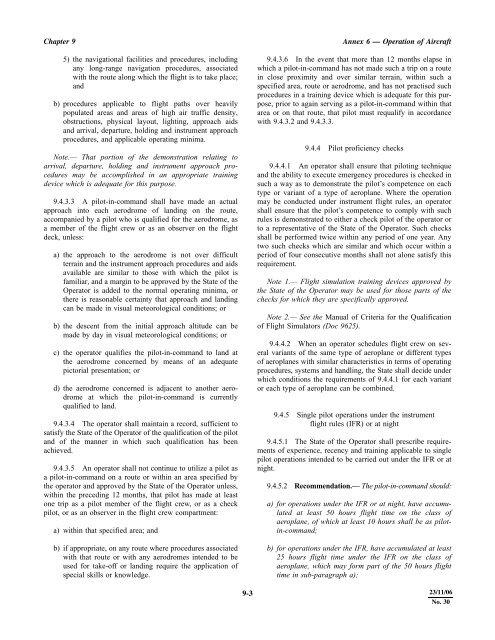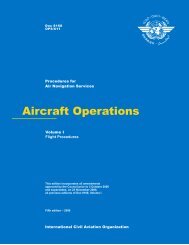Operation of Aircraft
Annex 6, Part I
Annex 6, Part I
- No tags were found...
Create successful ePaper yourself
Turn your PDF publications into a flip-book with our unique Google optimized e-Paper software.
Chapter 9<br />
5) the navigational facilities and procedures, including<br />
any long-range navigation procedures, associated<br />
with the route along which the flight is to take place;<br />
and<br />
b) procedures applicable to flight paths over heavily<br />
populated areas and areas <strong>of</strong> high air traffic density,<br />
obstructions, physical layout, lighting, approach aids<br />
and arrival, departure, holding and instrument approach<br />
procedures, and applicable operating minima.<br />
Note.— That portion <strong>of</strong> the demonstration relating to<br />
arrival, departure, holding and instrument approach procedures<br />
may be accomplished in an appropriate training<br />
device which is adequate for this purpose.<br />
9.4.3.3 A pilot-in-command shall have made an actual<br />
approach into each aerodrome <strong>of</strong> landing on the route,<br />
accompanied by a pilot who is qualified for the aerodrome, as<br />
a member <strong>of</strong> the flight crew or as an observer on the flight<br />
deck, unless:<br />
a) the approach to the aerodrome is not over difficult<br />
terrain and the instrument approach procedures and aids<br />
available are similar to those with which the pilot is<br />
familiar, and a margin to be approved by the State <strong>of</strong> the<br />
Operator is added to the normal operating minima, or<br />
there is reasonable certainty that approach and landing<br />
can be made in visual meteorological conditions; or<br />
b) the descent from the initial approach altitude can be<br />
made by day in visual meteorological conditions; or<br />
c) the operator qualifies the pilot-in-command to land at<br />
the aerodrome concerned by means <strong>of</strong> an adequate<br />
pictorial presentation; or<br />
d) the aerodrome concerned is adjacent to another aerodrome<br />
at which the pilot-in-command is currently<br />
qualified to land.<br />
9.4.3.4 The operator shall maintain a record, sufficient to<br />
satisfy the State <strong>of</strong> the Operator <strong>of</strong> the qualification <strong>of</strong> the pilot<br />
and <strong>of</strong> the manner in which such qualification has been<br />
achieved.<br />
9.4.3.5 An operator shall not continue to utilize a pilot as<br />
a pilot-in-command on a route or within an area specified by<br />
the operator and approved by the State <strong>of</strong> the Operator unless,<br />
within the preceding 12 months, that pilot has made at least<br />
one trip as a pilot member <strong>of</strong> the flight crew, or as a check<br />
pilot, or as an observer in the flight crew compartment:<br />
a) within that specified area; and<br />
b) if appropriate, on any route where procedures associated<br />
with that route or with any aerodromes intended to be<br />
used for take-<strong>of</strong>f or landing require the application <strong>of</strong><br />
special skills or knowledge.<br />
Annex 6 — <strong>Operation</strong> <strong>of</strong> <strong>Aircraft</strong><br />
9.4.3.6 In the event that more than 12 months elapse in<br />
which a pilot-in-command has not made such a trip on a route<br />
in close proximity and over similar terrain, within such a<br />
specified area, route or aerodrome, and has not practised such<br />
procedures in a training device which is adequate for this purpose,<br />
prior to again serving as a pilot-in-command within that<br />
area or on that route, that pilot must requalify in accordance<br />
with 9.4.3.2 and 9.4.3.3.<br />
9.4.4 Pilot pr<strong>of</strong>iciency checks<br />
9.4.4.1 An operator shall ensure that piloting technique<br />
and the ability to execute emergency procedures is checked in<br />
such a way as to demonstrate the pilot’s competence on each<br />
type or variant <strong>of</strong> a type <strong>of</strong> aeroplane. Where the operation<br />
may be conducted under instrument flight rules, an operator<br />
shall ensure that the pilot’s competence to comply with such<br />
rules is demonstrated to either a check pilot <strong>of</strong> the operator or<br />
to a representative <strong>of</strong> the State <strong>of</strong> the Operator. Such checks<br />
shall be performed twice within any period <strong>of</strong> one year. Any<br />
two such checks which are similar and which occur within a<br />
period <strong>of</strong> four consecutive months shall not alone satisfy this<br />
requirement.<br />
Note 1.— Flight simulation training devices approved by<br />
the State <strong>of</strong> the Operator may be used for those parts <strong>of</strong> the<br />
checks for which they are specifically approved.<br />
Note 2.— See the Manual <strong>of</strong> Criteria for the Qualification<br />
<strong>of</strong> Flight Simulators (Doc 9625).<br />
9.4.4.2 When an operator schedules flight crew on several<br />
variants <strong>of</strong> the same type <strong>of</strong> aeroplane or different types<br />
<strong>of</strong> aeroplanes with similar characteristics in terms <strong>of</strong> operating<br />
procedures, systems and handling, the State shall decide under<br />
which conditions the requirements <strong>of</strong> 9.4.4.1 for each variant<br />
or each type <strong>of</strong> aeroplane can be combined.<br />
9.4.5 Single pilot operations under the instrument<br />
flight rules (IFR) or at night<br />
9.4.5.1 The State <strong>of</strong> the Operator shall prescribe requirements<br />
<strong>of</strong> experience, recency and training applicable to single<br />
pilot operations intended to be carried out under the IFR or at<br />
night.<br />
9.4.5.2 Recommendation.— The pilot-in-command should:<br />
a) for operations under the IFR or at night, have accumulated<br />
at least 50 hours flight time on the class <strong>of</strong><br />
aeroplane, <strong>of</strong> which at least 10 hours shall be as pilotin-command;<br />
b) for operations under the IFR, have accumulated at least<br />
25 hours flight time under the IFR on the class <strong>of</strong><br />
aeroplane, which may form part <strong>of</strong> the 50 hours flight<br />
time in sub-paragraph a);<br />
9-3 1/11/01 23/11/06<br />
No. 30












